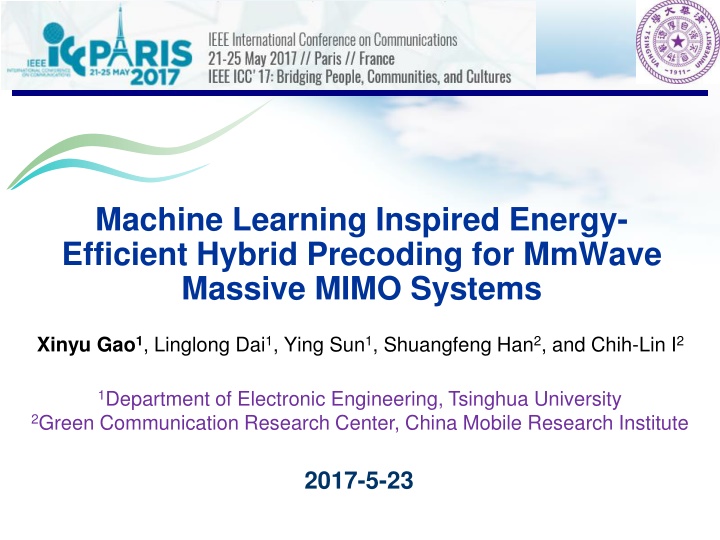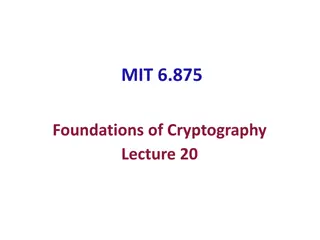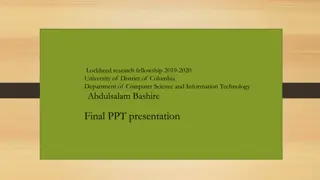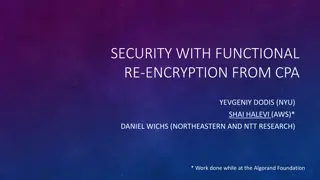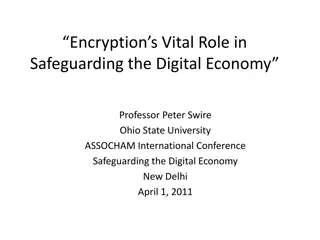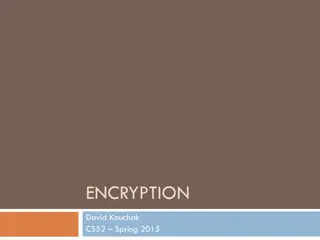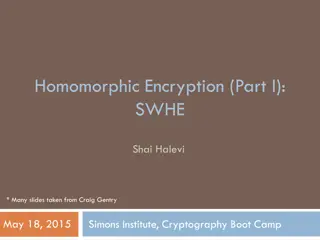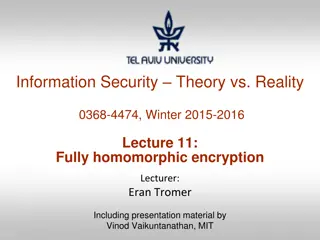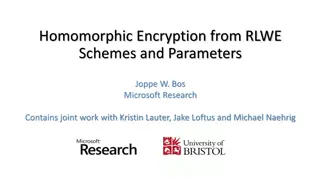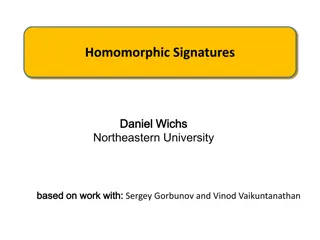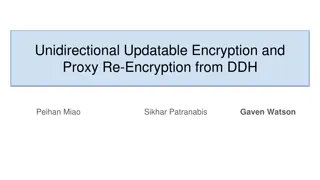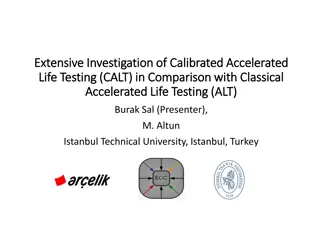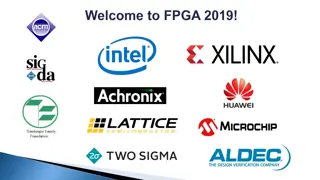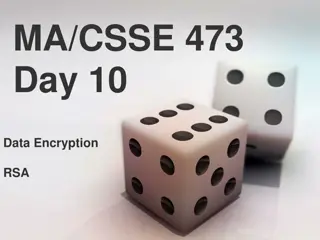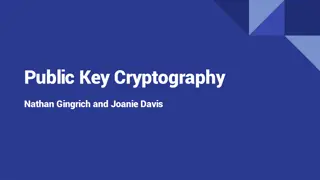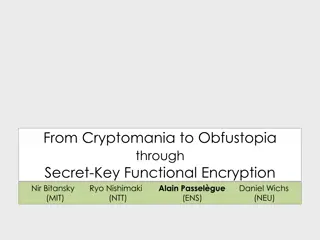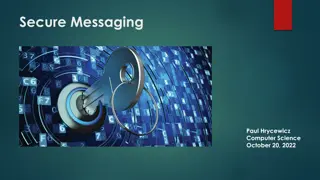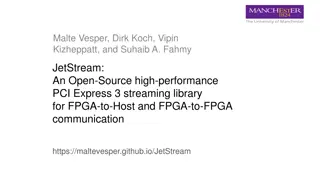Securing the Cloud with FPGA-accelerated Homomorphic Encryption
Design and develop an FPGA-based accelerator for homomorphic primitives to be used in heterogeneous computing environments. Explore the challenges of performing computations directly on ciphertexts and delegating computation to untrusted parties in a secure manner. This project aims to provide an alternative to software-only approaches and enhance the efficiency of encryption operations in cloud computing.
Download Presentation

Please find below an Image/Link to download the presentation.
The content on the website is provided AS IS for your information and personal use only. It may not be sold, licensed, or shared on other websites without obtaining consent from the author.If you encounter any issues during the download, it is possible that the publisher has removed the file from their server.
You are allowed to download the files provided on this website for personal or commercial use, subject to the condition that they are used lawfully. All files are the property of their respective owners.
The content on the website is provided AS IS for your information and personal use only. It may not be sold, licensed, or shared on other websites without obtaining consent from the author.
E N D
Presentation Transcript
Machine Learning Inspired Energy- Efficient Hybrid Precoding for MmWave Massive MIMO Systems Xinyu Gao1, Linglong Dai1, Ying Sun1, Shuangfeng Han2, and Chih-Lin I2 1Department of Electronic Engineering, Tsinghua University 2Green Communication Research Center, China Mobile Research Institute 2017-5-23
2 Contents 1 Technical background 2 Proposed solution 3 Simulation results 4 Conclusions 2/21 Xinyu Gao: Machine learning inspired energy-efficient hybrid precoding for mmWave massive MIMO systems
3 Advantages of mmWave massive MIMO Advantages High frequency (30-300 GHz): wider bandwidth (20 MHz 2 GHz) Short wavelength: largerantenna array (1~8 256~1024) Serious path-loss and blockage: more suitable for small cells mmWave High frequency Short wavelength Serious path-loss Wide bandwidth Large antenna array Small cell 1000x data rates increase! 3/21 Xinyu Gao: Machine learning inspired energy-efficient hybrid precoding for mmWave massive MIMO systems
4 Bottleneck of mmWave massive MIMO Challenges Traditional fully digital MIMO: one RF chain for one antenna Large antenna array Enormous number of RF chains RF chain is energy-intensive at mmWave (300 mW/RF chain) High energy consumption is the bottleneck problem 256 antennas at BS 76.8 W (only RF chains) Micro-cell BS in 4G (baseband + RF + transmit): less than 10 W How to reduce the number of RF chains? 4/21 Xinyu Gao: Machine learning inspired energy-efficient hybrid precoding for mmWave massive MIMO systems
Hybrid analog and digital precoding Basic idea[Ayach 14] Decompose the high-dimension fully digital precoder High-dimension analog beamformer (realized by analog circuit) Low-dimension digital precoder (requires RF chains) MmWave MIMO channel is low-rank Limited number of data streams can be transmitted Low-dimension digital precoder is enough for multiplexing gain RF chain RF chain RF chain Analog circuit Low-dimension digital precoder High-dimension fully digital precoder RF chain RF chain (a) (b) [Ayach 14] O. El Ayach, et al., Spatially sparse precoding in millimeter wave MIMO systems, IEEE Trans. Wireless Commun., Sep. 2014. 5/21 Xinyu Gao: Machine learning inspired energy-efficient hybrid precoding for mmWave massive MIMO systems
Classical hybrid precoding architecture Phase shifter (PS)-based architecture [Rial,16] Full array gain near-optimal sum-rate performance Large number ( ) of energy-intensive PSs ( ) Switch (SW)-based architecture [Rial,16] No array gain serious performance loss Small number ( ) of energy-efficient SWs ( ) P = = 40mW 256 16 N N PS RF = = 16 N 5mW SW P RF Can we make a better trade-off between performance and energy consumption? [Rial 16] R. M ndez-Rial, et al., Hybrid MIMO architectures for millimeter wave communications: Phase shifters or switches? IEEE Access, Jan. 2016. 6/21 Xinyu Gao: Machine learning inspired energy-efficient hybrid precoding for mmWave massive MIMO systems
7 Contents 1 Technical background 2 Proposed solution 3 Simulation results 4 Conclusions 7/21 Xinyu Gao: Machine learning inspired energy-efficient hybrid precoding for mmWave massive MIMO systems
8 Switch and inverter (SI)-based architecture Basic idea Each RF chain is connected to a sub array with antennas Each RF chain-sub array pair consists of one inverter and switches Energy consumption is considerably low switches and inverters Both switch and inverter are energy-efficient ( ) = / M N N RF M N N RF = = 5mW SW P P IN Array gain Inverters and switches Splitter = N / N M N Lemma 1. When and , the ratio between the array gain achieved by SI- based architecture and that achieved by PS-based architecture with sufficiently high-resolution phase shifters can be presented by RF Chain RF Digital precoder Inverter RF Chain 4 = lim 2 N N M = , N N Analog beamformer RF RF How to design hybrid precoding scheme for new architecture? 8/21 Xinyu Gao: Machine learning inspired energy-efficient hybrid precoding for mmWave massive MIMO systems
Problem formulation System model = + :Analog beamformer ( ) , : Digital precoder ( N N F y HF F s n F , N K ) RF RF BB BB RF RF Optimization problem ( RF BB , F F ) = opt opt argmax , F F R Inverters and switches Splitter , RF F BB s.t. F , RF Chain RF F F 2 = Digital precoder , Inverter RF BB F RF Chain Constraints Total transmit power constraint: Hardware constraint on analog beamformer: ( RF 1 blkdiag F f 2 = F F Analog beamformer RF BB F ) = RF RF 2 f RF N f , , , , Non-convex! N N N RF RF , 1 N 1, 1 , + RF , i j = = f 1,2, L , 1,2, L , j M i RF 9/21 Xinyu Gao: Machine learning inspired energy-efficient hybrid precoding for mmWave massive MIMO systems
10 Inspiration F F Decouple the joint design of and Given , the constraints become convex Conventional scheme can be used to obtain based on The number of possible We can try all possible BB RF F RF HF F RF BB F s is finite s to maximize the sum-rate RF F RF F Employ cross-entropy (CE) algorithm to search The complexity of searching all possible possible Employ CE algorithm developed from machine learning to search Search the solution space in a more intelligent way Obtain the near-optimal solution with significantly reduced complexity RF F 2N s is unaffordable RF F N = s 64 64 19 2 1.84 10 RF F RF 10/21 Xinyu Gao: Machine learning inspired energy-efficient hybrid precoding for mmWave massive MIMO systems
11 Principle of CE algorithm Key idea Randomly generate Compute sum-rate (objective value) for each candidate Select best candidates as elite samples ( ) Update the probability distribution by minimizing the CE S candidates according to a probability distribution S 1 S S elite elite Cross entropy: ( , H P Q Probability distribution Random candidates ( ) ( ) P i Q i + ) ( ) ( ) Cross-entropy minimization = log H P P i i Elite candidates Minimization Disadvantage of conventional CE algorithm All elite samples are treated as the same The elite sample with higher object value is more important Adaptively weight the elites better performance? 11/21 Xinyu Gao: Machine learning inspired energy-efficient hybrid precoding for mmWave massive MIMO systems
12 Adaptive CE (ACE)-based hybrid precoding Initialization Collect nonzero elements of in a vector Set the iteration counter Set the initial distribution ( ) u F = RF RF 2 f RF N T T T T f f f [( ) ,( ) , ( ) ] N RF 1 RF i = 0 ( ) 1 2 ( ) i ( ) i n = = = 1 Pr 1/ u f N N 1 n Step 1 Randomly generate analog beamformers based on Compute digital precoders based on S ( eq eq eq = G H H H ( ) H S ( ) i s F S u F ; RF s= 1 s S s = F s HF BB eq RF s= 1 = ) ( 1 ) ( ) H H = s s s s s s s s s s F G F G , , / BB RF F Step 2 Calculate the achievable sum-rate Sort in an descend order: ( RF s ) ( ) S s F R RF ) = ( S 1 s s F R ( ) ( ) = 1 1 RF 2 RF RF S F F F R R R 1 RF 2 RF RF S F F F , , , Select elites as elite 12/21 Xinyu Gao: Machine learning inspired energy-efficient hybrid precoding for mmWave massive MIMO systems
13 ACE-based hybrid precoding scheme Step 3 Calculate weight for each elite RF s s w F ( ) ( ) 1 RF/ F RF S s s = = 1 s S F , s w R T T R elite 1 = elite S s elite Step 4 Update according to elites and weights Equivalent problem of weighted CE minimization S i S = S w RF ( ) 1 S elite s i+ F u elite 1 = s s s= 1 RF ) ) ( ( s F 1 2 1 2 ( ) s n s n ( ) ( ) w N PDF of + elite 1 1 N f N f RF ( ) ( ) i ( ) i n ( ) i n + 1 s = u F u argmax ln ; s 1 u u ( ) i u 1 s = 1 n ( ) i n u Compute first-order derivative of and set them to zero = ( ) s n S + 1 w N f elite 1 = ( n ) s + s 1 i u S 2 w elite 1 = s Step 5 Repeat Steps 1 - 4 for iterations Output as analog beamformer and as digital precoder RF F s I 1 1 BB F 13/21 Xinyu Gao: Machine learning inspired energy-efficient hybrid precoding for mmWave massive MIMO systems
14 Complexity analysis Step 1 Compute with complexity Compute with complexity BB F ( ( ) ) S s H 2 O O SNK SNK eq s s= S 1 2 s= 1 Step 2 ZF precoder, SINR is simplified as with complexity ( ) 2 ( ) S k = s s / O Step 3 Calculate weights with complexity w ( ) S elite 1 = O S s elite s Step 4 Update probability distribution with complexity ( ) 1 ( ) i+ u O NS elite Total complexity After iterations, the complexity is Comparable with LS algorithm, as and do not need to be large ( I ) I 2 O ISNK S 14/21 Xinyu Gao: Machine learning inspired energy-efficient hybrid precoding for mmWave massive MIMO systems
15 Contents 1 Technical background 2 Proposed solution 3 Simulation results 4 Conclusions 15/21 Xinyu Gao: Machine learning inspired energy-efficient hybrid precoding for mmWave massive MIMO systems
16 Achievable sum-rate comparison 30 Simulation setup Multipath channel model UPA with Complex gain: AoA/AoD: 200, S = Fully digital ZF precoding Conventional two-stage hybrid precoding Conventional AS-based hybrid precoding Proposed CE-based hybrid precoding Proposed ACE-based hybrid precoding N = = = 64, 4 N K 25 RF Achievable sum-rate (bps/Hz) = = = 3 / 2 d L d 20 1 2 = = = L L L 1 2 3 4 ( ) 15 CN 0,1 ) ( U , 10 I = = 20 40, S elite 5 Observations ACE algorithm outperforms CE algorithm with negligible complexity increase Obvious improvement vs AS-based hybrid precoding (SW-based architecture) Satisfying vs two-stage hybrid precoding (PS-based architecture) 0 -20 -15 -10 -5 0 5 10 SNR (dB) [Rial 15] R. M ndez-Rial, et al., Channel estimation and hybrid combining for mmWave: Phase shifters or switches? in Proc. ITA Workshops, Feb. 2015. [Alkhateeb 15] A. Alkhateeb, et al., Limited feedback hybrid precoding for multi-user millimeter wave systems, IEEE Trans. Wireless Commun., Nov. 2015. 16/21 Xinyu Gao: Machine learning inspired energy-efficient hybrid precoding for mmWave massive MIMO systems
17 Convergence 19 Simulation setup Multipath channel model UPA with Complex gain: AoA/AoD: SNR = 10 dB, Limited improvement! S = 50 S = 100 S = 150 S = 200 S = 250 N = = = 64, 4 18 N K RF 17 Achievable sum-rate (bps/Hz) = = = 3 / 2 d L d 16 1 2 = = = L L L 1 2 3 4 15 ( ) CN 0,1 ) ( 14 U , S = elite/ 0.2 S 13 12 11 10 Observations ACE-based hybrid precoding converges with a small (e.g., ) A relative small number of candidates is enough (e.g., ) 2 4 6 8 10 12 14 16 18 20 Number of iterations I I I = 200 20 S = S 17/21 Xinyu Gao: Machine learning inspired energy-efficient hybrid precoding for mmWave massive MIMO systems
18 Energy efficiency (EE) comparison Energy efficiency Two-stage hybrid precoding: P N = + 8 = / R P Fully digital ZF precoding Conventional two-stage hybrid precoding Conventional AS-based hybrid precoding Proposed ACE-based hybrid precoding T 7 + + P P NN P 6 Energy efficience (bps/Hz/W) T RF RF BB RF PS AS-based hybrid precoding P N P = + 5 + + P RF SW N P T RF RF BB 4 ACE-based hybrid precoding N P P = + + + + 3 P N P N SW P T RF RF BB RF IN Simulation parameters 2 P = 200mW, = P P = 40mW 1W, P = 300mW, P 5mW, PS RF = 1 = BB SW IN 0 2 4 6 8 10 12 14 16 Number of users K Observations ACE-based hybrid precoding achieves the highest EE Two-stage hybrid precoding only performs well when is small (e.g., ) K K 8 [Rial 16] R. M ndez-Rial, et al., Hybrid MIMO architectures for millimeter wave communications: Phase shifters or switches? IEEE Access, Jan. 2016 [Rappaport 13] T. S. Rappaport, et al., Millimeter wave mobile communications for 5G cellular: It will work! IEEE Access, May 2013 18/21 Xinyu Gao: Machine learning inspired energy-efficient hybrid precoding for mmWave massive MIMO systems
19 Contents 1 Technical background 2 Proposed solution 3 Simulation results 4 Conclusions 19/21 Xinyu Gao: Machine learning inspired energy-efficient hybrid precoding for mmWave massive MIMO systems
20 Summary and conclusions SI-based hybrid precoding architecture Design a new architecture with a small number of switches and inverters Enjoy low energy consumption and near-optimal array gain ACE-based hybrid precoding scheme Propose an ACE algorithm with low complexity for the new architecture Achieve satisfying sum-rate performance and much higher EE Inverters and switches Splitter RF Chain Probability distribution Random candidates Cross-entropy minimization Digital precoder Inverter RF Chain Elite candidates Analog beamformer 20/21 Xinyu Gao: Machine learning inspired energy-efficient hybrid precoding for mmWave massive MIMO systems
21 Thank you ! Contact information Xinyu Gao xy-gao14@mails.tsinghua .edu.cn & xgao237@wisc.edu 21/21 Xinyu Gao: Machine learning inspired energy-efficient hybrid precoding for mmWave massive MIMO systems
